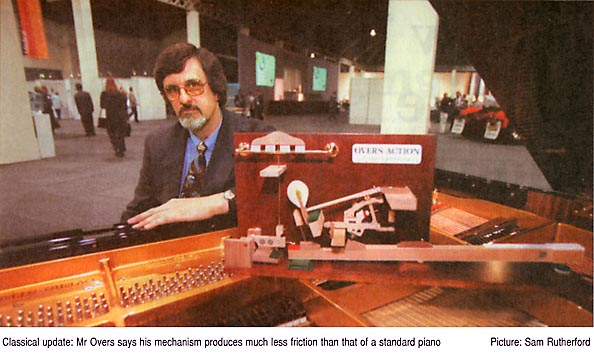

By Paul Broekhuyse
19 September, 2000AN instrument maker has used CAD technology to redesign the innards of a grand piano, giving master musicians much greater control over the instrument.
Sydney piano rebuilder Ron Overs says his revolutionary action -- the mechanism that connects the piano keys to the hammers that strike the strings -- produces much less friction than the standard device, which has not changed for about 200 years."The main advantage is a greater level of control for the pianist," he said. "Excess friction robs energy from a pianist's finger when a key is struck, and when the finger is lifted, friction causes the note to slow on the return."
Young pianists would find it easier to master grand pianos, because the keys were easier to play, he said.
Mr Overs redesigned the action after deciding to build his own pianos. "There were two companies making piano actions at the time -- Tokiwa, and Renner in Germany -- and I was considering which one to use," he said.
"I came to the conclusion that none of them were designed to minimise lost friction, so I decided to design my own." He used CAD (computer-assisted drawing) software for the task.
"When I'm designing with CAD, I can look at the parts and build each stage virtually, run a scenario through and look at it and see where the levers are going to be, without having to actually build it all," Mr Overs said.
"It's a wonderful design tool. To make a model by hand, it must be absolutely accurate, and that takes a lot of time. It takes about 600 labour hours to build a grand piano in a factory, for example."
With CAD, Mr Overs was able to virtually test the various configurations of the levers in a piano action, eventually arriving at a much more efficient arrangement.
"It is complex, but basically you have to ensure that the levers contact each other at the appropriate location between the two fulcrum points," he said.
"Contemporary pianos have a significant offset, which introduces a lot of unnecessary friction."
The actions offer faster response times and more sound output than earlier efforts. This makes both loud and soft passages easier to play. The reduced friction also translates into less wear and tear.
Mr Overs won a tied promotional grant under the NSW Government's Australian Technology Showcase program. The winners displayed their wares at Fox Studios in Sydney last week.
The mechanism received another vote of confidence when renowned concert pianist Gerard Willems agreed to record on a piano equipped with it.
First published in The Australian IT, September 1 2000.